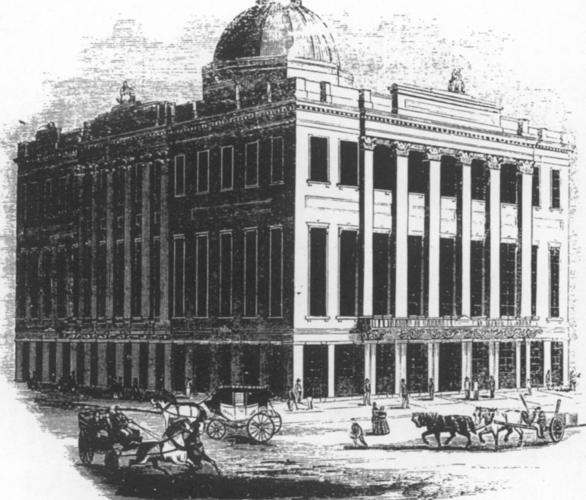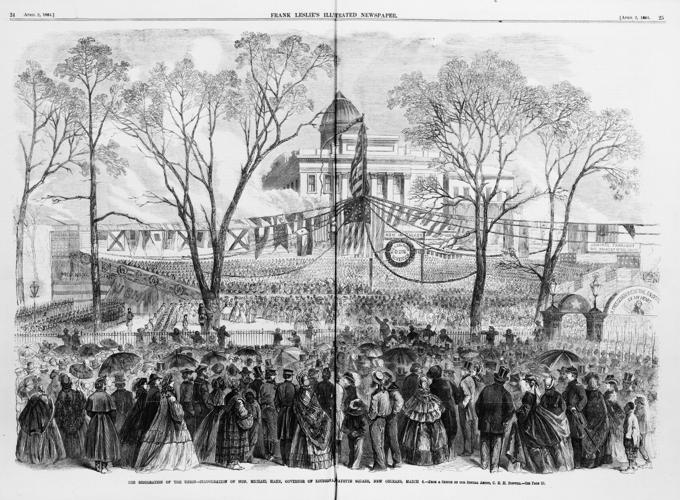Of all the clubs, fraternities, coffee klatches and confederacies formed in New Orleans over the years — of dunces and otherwise — one stands out as particularly, well, odd.
It was the Independent Order of Odd Fellows, a Mason-like benevolent society with roots in 18th-century England, and the name of which has adorned a number of public places in New Orleans.
That notably includes the colorfully and memorably named Odd Fellows Rest cemetery, which, though largely neglected, still reposes today at Canal Street and City Park Avenue.
The Odd Fellows name was also, however, attached to one of the city’s most prominent buildings of the late 1800s, and in one of its most prominent locations, to boot.
So who were these Odd Fellows? And what of their building?
Chapters across America
The order first established itself in America in 1819, with a chapter in Baltimore. In an era in which membership in civic and fraternal organizations was in vogue, other chapters soon began popping up across America.
That included in New Orleans, where a lodge was chartered in 1831 for “religious, charitable and literary purposes,” according to former city attorney Francis P. Burns, writing in 1963 for the journal of the Louisiana Historical Association.
By 1846, the Odd Fellows had established a clubhouse at 13 Camp St. and, as one of their first major local projects, set about establishing a cemetery for its members. Three years later, Odd Fellows Rest was dedicated, its cast-iron gates adorned with various Odd Fellows symbols, including a beehive, an all-seeing eye, a five-pointed star and an image of the Bible.
(Most of those symbols have since disappeared, aside from the likeness of a widow and child, and a cornucopia. A three-link chain, also a symbol of Odd Fellowship, occupies the cement lintel above the gate.)
That same year, the order purchased land facing Lafayette Square on the block bounded by Camp, Lafayette, Magazine and Girod, and then cleared the site of “the unsightly shanties which have so long marred its appearance,” according to The Daily Picayune.
Inspired by a Greek temple
Architect George Purvis — who also had a hand in designing the second St. Charles Hotel, which was going up at the time — was then hired to design the Odd Fellows a new home.
Inspired by the Greek Temple of Diana, the neoclassical structure would be an imposing one, standing three stories, with rented storefronts on the ground floor and a large central dome atop.
The new lodge would notably also boast a massive ballroom, measuring 132 feet by 60 feet and with 36-foot-high ceilings, designed to host concerts and social affairs. Although the building was still under construction in early October 1852, it was far enough along to host its first musical performance, by Messemer’s Brass Band.
The next month, however, plans for “a Grand Dedication Ball” had to be put on hold, according to the Picayune, “in consequence of the non-arrival of the ship Carnatic, having on board the Chandeliers and Gas Fixtures for the Ball Room.”
A dedication was, indeed, held on Nov. 22, although apparently without a ball. The day did, however, include a parade through the city by members of what by then was more than a dozen local Odd Fellows lodges, all dressed in full regalia, followed by speechifying at the new hall.
A triple funeral
Just more than two weeks later, on Dec. 9, the new lodge would host what would be among its most noteworthy events: a massive, communitywide funeral in honor of the U.S. Senate’s so-called “Great Triumvirate” of Henry Clay, John C. Calhoun and Daniel Webster, whose outsized influence dominated American politics of the era.
(Calhoun had already been dead for almost two years by that time, but Clay and Webster were both fresh in the ground, having died within five months of each other, in June and October 1852, respectively.)
“For weeks preceding, the citizens of New Orleans busied themselves in making great preparations for the ceremony,” Burns wrote. “The city was decorated with somber and solemn emblems of grief, attesting the feelings of the people for the deceased statesmen.”
Central to it all was another Odd Fellows parade through the city. In addition, a cenotaph was erected in the middle of Lafayette Square — where the city’s famed statue of Henry Clay now stands — upon which three symbolic funeral urns were ceremoniously deposited.
Additionally, three eulogies were held. One for Calhoun was held at City Hall, Webster’s was held at First Presbyterian Church, and Clay’s was held in the Odd Fellows’ ballroom.
Not counting the years of the Civil War, when the lodge — like the city — was occupied by the Union Army, the hall would continue to be a center of local social life until the night of July 4, 1866, when it burned in a spectacular midnight blaze.
Years of decline
The next morning, the charred walls still stood, but the building was a total loss.
The Odd Fellows sold the site and rebuilt at a new location on Camp Street, between Poydras and Lafayette. That building would be foreclosed upon in 1937 for an unpaid mortgage, a reflection of the once-prominent group’s declining membership — and its declining impact on the community.
Meanwhile, by 1875, St. Patrick’s Hall — another noteworthy public hall in the city’s history — would replace the original Odd Fellows Hall on Lafayette Square. St. Patrick’s Hall would be demolished around 1908 after being sold to the federal government.
Replacing it: the John Minor Wisdom federal court building.
Home to the 5th U.S. Circuit Court of Appeals, it still occupies the site today.
Sources: The Times-Picayune archive; Louisiana History: The Journal of the Louisiana Historical Association, Winter 1963; Library of Congress.
Do you know of a New Orleans building worth profiling in this column, or are you just curious about one? Contact Mike Scott at moviegoermike@gmail.com.


